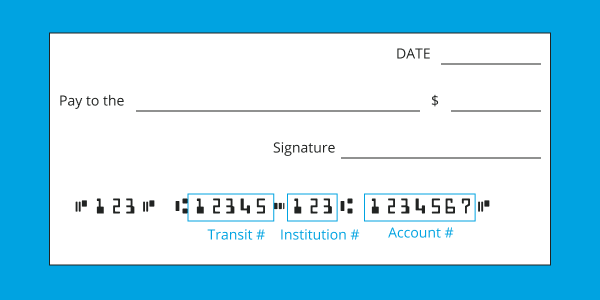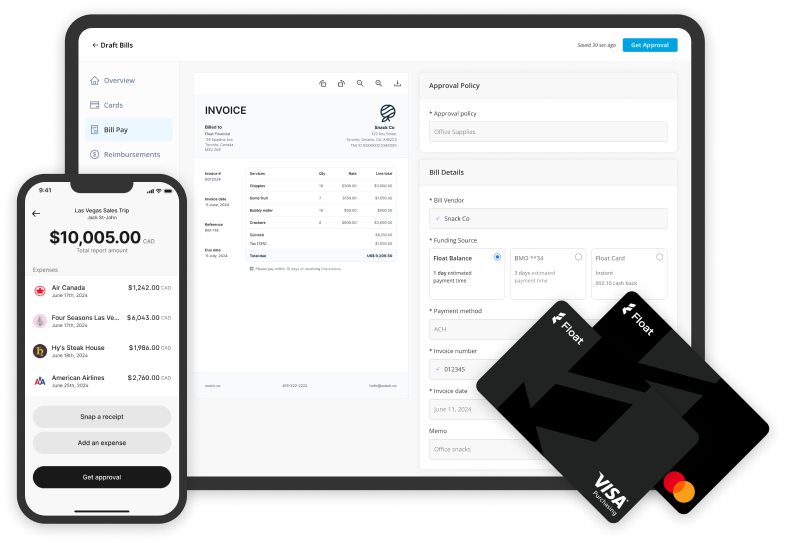RBC Transit, Routing, Institution Numbers, and SWIFT Code
Find the Royal Bank of Canada institution number, transit number, and routing number for domestic or international wire transfers — and if you’re paying a vendor bill, save on fees and pay faster with Float.
RBC Institution Number
The institution number for the Royal Bank of Canada (RBC) is:
003
What is an institution number?
An institution number is a unique three-digit code used by Canadian banks and financial institutions to identify themselves in the national financial system.
RBC SWIFT Code
The SWIFT code for the Royal Bank of Canada (RBC) is:
ROYCCAT2
What is a SWIFT code?
A SWIFT code is an international bank identifier used to facilitate secure and standardized cross-border transactions. It consists of 8 to 11 characters, representing the bank, country, location, and branch. SWIFT codes ensure accurate routing of international wire transfers between financial institutions worldwide.
What is a Transit or Routing Number?
What is an transit number?
A transit number in Canadian banking is a five-digit code used to identify the specific branch of a financial institution where a bank account is held. It is part of the essential information needed for processing electronic funds transfers, direct deposits, and bill payments.
What is a routing number?
In Canada, a routing number is a combination of a transit number and an institution number that uniquely identifies a specific bank branch. It is used to facilitate financial transactions such as direct deposits, electronic fund transfers (EFTs), and wire transfers.
The Canadian routing number format is a 9-digit code, broken down into two parts:
- Transit number: A 5-digit number that identifies the specific branch of a bank.
- Institution number: A 3-digit number that identifies the financial institution (e.g., Royal Bank of Canada’s institution number is 003).
The format for a Canadian routing number is typically 0YYYXXXXX, where:
0is a leading zero,YYYis the institution number, andXXXXXis the transit number.
For example, if the transit number is 12345 and the institution number is 003 (RBC), the routing number would be 000312345.
What is the account number?
The account number on a cheque is a unique number assigned to an individual’s bank account, used to identify that specific account for financial transactions such as deposits, withdrawals, and transfers. It is typically found at the bottom of a cheque, following the transit number and institution number.

All Your Questions Answered
An IBAN (International Bank Account Number) is a standardized format used to identify bank accounts internationally, ensuring smooth cross-border transactions. It includes the country code, check digits, and the local bank account details. A SWIFT code (or BIC – Bank Identifier Code) is an 8-11 character code that identifies a specific bank during international transfers. The IBAN identifies the individual account, while the SWIFT code identifies the bank.
Both are required when sending money abroad and most often for WIRE transfers: the IBAN is used in regions like Europe, and the SWIFT code is used globally to identify the recipient’s bank for secure international transfers.
A Bank Identifier Code (BIC), also known as a SWIFT code, is an 8-11 character code used to uniquely identify banks and financial institutions worldwide for international transactions. It ensures that payments reach the correct institution. The code typically consists of the bank’s name, country, location, and optional branch identifier. BIC codes are essential for wire transfers, international money transfers, and other secure communication between banks globally.
ACH (Automated Clearing House) is a type of bank to bank payment method used in the U.S. for transactions like direct deposits and bill payments, processing batch payments between banks. In Canada, EFT refers to similar electronic money transfers, such as payroll deposits or vendor payments, across Canadian banks. ACH is U.S.-specific, while EFT is used in Canada.
Find RBC Transit, Routing, and Institution Numbers
Search for the transit, routing number by branch name, city, or province.




